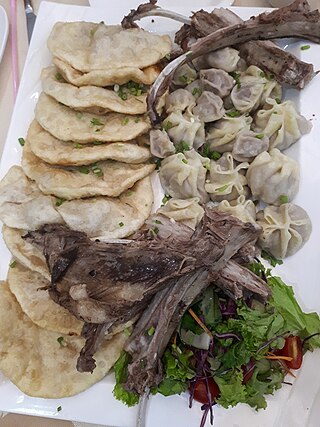
Turkish cuisine is the cuisine of Turkey and the Turkish diaspora. The cuisine took its current form after numerous cultural interactions throughout centuries, descending from earlier stages of Turkish cuisine, Ottoman cuisine and Seljuk cuisine. Turkish cuisine with traditional Turkic elements such as yogurt, ayran, kaymak, exerts and gains influences to and from Mediterranean, Balkan, Middle Eastern, Central Asian and Eastern European cuisines.

Polish cuisine is a style of food preparation originating in and widely popular in Poland. Due to Poland's history, Polish cuisine has evolved over the centuries to be very eclectic, and shares many similarities with other national cuisines. Polish cooking in other cultures is often referred to as à la polonaise.

Russian cuisine is a collection of the different dishes and cooking traditions of the Russian people as well as a list of culinary products popular in Russia, with most names being known since pre-Soviet times, coming from all kinds of social circles.

Pelmeni are dumplings of Russian cuisine that consist of a filling wrapped in thin, unleavened dough.

Czech cuisine has both influenced and been influenced by the cuisines of surrounding countries and nations. Many of the cakes and pastries that are popular in Central Europe originated within the Czech lands. Contemporary Czech cuisine is more meat-based than in previous periods; the current abundance of farmable meat has enriched its presence in regional cuisine. Traditionally, meat has been reserved for once-weekly consumption, typically on weekends.

Tatar cuisine is primarily the cuisine of the Volga Tatars, who live in Tatarstan, Russia, and surrounding areas.

Mongolian cuisine predominantly consists of dairy products, meat, and animal fats. The most common rural dish is cooked mutton. In the city, steamed dumplings filled with meat—"buuz"— are popular.

Buuz are a type of Mongolian steamed dumpling filled with meat. An example of authentic Mongolian and Buryatian cuisine, the dish is traditionally eaten at home during Tsagaan Sar, the Lunar New Year. In modern times it is also offered at restaurants and small cafes ("guanz") throughout the capital city of Ulaanbaatar.

Javanese cuisine is the cuisine of Javanese people, a major ethnic group in Indonesia, more precisely the province of Central Java, Yogyakarta and East Java.

A great variety of cassava-based dishes are consumed in the regions where cassava is cultivated. Manihot esculenta is a woody shrub of the spurge family, Euphorbiaceae, native to South America, from Brazil, Paraguay and parts of the Andes.
Romani cuisine is the cuisine of the ethnic Romani people. There is no specific "Roma cuisine"; it varies and is culinarily influenced by the respective countries where they have often lived for centuries. Hence, it is influenced by European cuisine even though the Romani people originated from the Indian subcontinent. Their cookery incorporates Indian and South Asian influences, but is also very similar to Hungarian cuisine. The many cultures that the Roma contacted are reflected in their cooking, resulting in many different cuisines. Some of these cultures are Middle European, Germany, Great Britain, and Spain. The cuisine of Muslim Romani people is also influenced by Balkan cuisine and Turkish cuisine. Many Roma do not eat food prepared by non-Roma.

Dumpling is a broad class of dishes that consist of pieces of cooked dough, often wrapped around a filling. The dough can be based on bread, wheat or other flours, or potatoes, and it may be filled with meat, fish, tofu, cheese, vegetables, or a combination. Dumplings may be prepared using a variety of cooking methods and are found in many world cuisines.

A wonton is a type of Chinese dumpling commonly found across regional styles of Chinese cuisine. It is also spelled wantan or wuntun in transliteration from Cantonese 雲吞 / 云吞 and wenden from Shanghainese 餛飩 / 馄饨. Even though there are many different styles of wonton served throughout China, Cantonese wontons are the most popular in the West due to the predominance of Cantonese restaurants overseas.

Jiaozi are a type of Chinese dumpling. Jiaozi typically consist of a ground meat or vegetable filling wrapped into a thinly rolled piece of dough, which is then sealed by pressing the edges together. Jiaozi can be boiled (shuǐjiǎo), steamed (zhēngjiǎo), pan-fried (jiānjiǎo), or deep-fried (zhàjiǎo), and are traditionally served with a black vinegar and sesame oil dip. They can also be served in a soup. Jiaozi have great cultural significance within China. Jiaozi are one of the major dishes eaten during the Chinese New Year throughout northern China and eaten all year round in the northern provinces. Their resemblance to the gold and silver ingots (sycee) used in Imperial China has meant that they symbolize wealth and good fortune.

Aush jushpare is a type of aush, commonly cooked in Khorasan, Gonabad, Ferdous and Sabzevar in Iran. It is similar to the Chinese jiaozi. Historian Bayhaqi (-1077) mentioned about Aush Jushpare in his book "Tarikh-i Bayhaqi". Aush Jushpare is one of the oldest Aush, but since it takes a lot of time for preparation, it is not commonly eaten now. It is rather a dish of hospitality, which people eat on the occasion of special gatherings or festivals. Traditional guest house restaurant serves Aush Jushpare as local specialty. Aush Jushpare was registered as intangible heritage of Iran on 5 January 2021.

Pontic Greek cuisine consists of foods traditionally eaten by Pontic Greeks, a Greek-speaking ethnic minority that originates from the southern shore of the Black Sea in modern Turkey. Their cuisine has been heavily influenced by the migration of different ethnic groups to the Pontos. Because of the Pontos' remote location, Pontic Greek cuisine has many differences from other Greek cuisines. According to Achillefs Keramaris et al., "Pontic Greek traditional cuisine is diverse and simplistic, incorporating traditions from mountainous and coastal regions, ancient Greece, nomadic regions, and influences from Russian, Turkish, Laz, Hemshin, and Armenian cuisines."

















